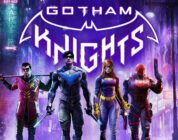The year is 1940. Batman is still relatively new to the comic scene, and Robin had just made his debut. It’s that period where our hero is still in touch with his pulp roots, and the stories are still dark, but slowly getting more to the comics we know. And as far as enemies go, Batman has already faced threats like the Monk and Hugo Strange. But he’s about to meet the greatest enemy he’ll ever face: The Joker.
Batman vs. The Joker was written by Bill Finger and drawn by Bob Kane, the two responsible for all of Batman’s early adventures. Right off the bat (pardon the pun), there’s something ominous about this particular story, and it’s that splash image of the Joker, his mirthless grin as he looks over his shoulder at the reader. Just disturbing as it is, with Kane’s artwork conveying the menace in the clown. And we haven’t even gotten to the story.
Our tale begins with a radio show, interrupted by a message, stating Henry Claridge will die at midnight, and his diamond will be stolen. The threat is capped off with the words, “The Joker has spoken!”
That night, Claridge is surrounded by cops, as the seconds tick to midnight. As soon as the clock strikes twelve, he drops dead. His face twists into a horrific grin. And when the police check on the diamond, they find that it’s glass. We then cut to our first real view of Joker, as he broods in the dark (this image looks so much like Heath Ledger’s Joker, it’s unnerving). He then explains how he injected Claridge with a poison the previous night that would kill him in 24 hours, and switched the diamond, then continued with the threat.
In the space of three pages, Joker showed how deadly and intelligent he is. And we’re just getting started. More radio threats, more deaths (never the same method, but always the same result, that grin), and our villain gets the attention of Batman and Robin, as well as all the criminals who now want him dead.
Over the course of the story, Joker gets into a fist fight with Batman and wins, kills more people, uses disguises, and captures Robin. In the end, after a thrilling battle, Joker is captured by Batman. And, as he ominously states in the feature image, he is far from done.
In one story, we’re introduced to the key elements that make Joker such a perfect villain for Batman. While Batman is considered the greatest detective, Joker proves himself to be the ultimate criminal. He is also one of the first villains to beat Batman in a fight (a fact about him that sadly seems missing from modern stories). Like Batman, Joker also benefits from an iconic and frightening look. At no point in this story does Joker look humorous, his face matching the iconic Conrad Veidt. He actually looks scary when he smiles, and since this comic is from the 40’s, without cartoonish proportions, it’s easy to imagine what he’d look like in real life.
In the same magazine, Joker would have his second story, and at the end of it he died. And he would have stayed dead, if he didn’t turn out so popular. As a result, Joker had to conform to the Comic Authority Code, and so he slowly turned from a chilling murderer to a comical over-the-top crook. He would also get a semi-origin, explaining that he was once the Red Hood, a masked thief who escaped Batman by diving into chemicals.
As a starting story, and a tale of Joker’s early days, I can’t tell you enough of how good a story this is. If you want to read it, it’s been reprinted not just in DC’s Batman Omnibus line, but also in The Joker: The Greatest Stories Ever Told.
Tune in tomorrow, same bat-time, same bat-site, as we up the ante and shed a little light on the tragedy behind the Clown Prince of Crime in Allan Moore’s Batman: The Killing Joke.


